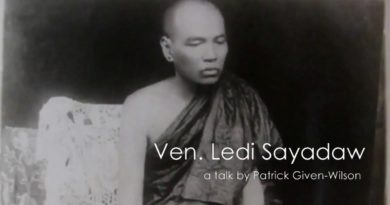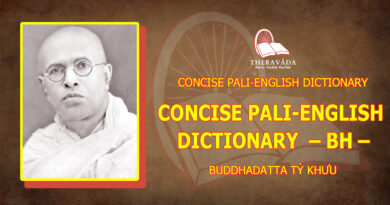THE CATUSACCA DIPANI – PART III: THE FOUR INTERPRETATIONS OF MAGGA-SACCA
THE CATUSACCA DIPANI – PART III: THE FOUR INTERPRETATIONS OF MAGGA-SACCA
Of the four aspects of nirodha-sacca (the Noble Truth of the Cessation of Suffering) and four aspects of magga-sacca (The Noble Truth of the Path Leading to the Cessation of Suffering) both of which are attainable and enjoyable by sotapannas (stream-winners), I shall now deal with the latter first. As has been explained before there are four interpretations of magga-sacca. They are:
- niyyanatho (release; deliverance)
- hetuttho (suitability for the attainment of arahatship)
- dassanatho (realization of the truth)
- adhipateyyatho (sovereignty; power).
- Of these, I shall expound how sotapannas are able to attain and enjoy the niyyanatho aspect of The Noble Truth of the Cessation of Suffering. When a person attains sotapattimagga (the path of stream- winning), miccha-ditthi (wrong understanding) and vicikiccha (sceptical doubt) that accompany him come to an end. All his accumulated old unwholesome kamma and those unwholesome actions that have been performed by him in the present life and are to take effect in successive births or future births become ineffective. He is thus free from falling to apaya-samsara (rebirth in the lower worlds) for ever. At most he will have to wander in the happy course of existence, such as the world of men, deva-planes and Brahma planes. Even in those planes, never would he arise as one who commits evil actions and who leads a bad mode of living; nor would he arise as one who is deprived of power, wealth and glory, He would only arise as one who is endowed with wisdom, glory, wealth and power. It is the law of cosmic order that such a being would never be reborn in a plane lower than he has arisen in, after his passing away from the present plane. If he so desires, he can take rebirth in the same old plane, or he can arise in a higher plane.In this manner he wanders in the happy course of existence for many a world-cycle. Although sotapannas wander in the happy course of existence, unlike the ordinary worldlings they do not drift along the current of samsara and are not destined to take rebirth in the lower worlds. From the moment they attain the Path of stream-winning, they are delivered from such evils as sakkaya-ditthi (personality-belief), vicikiccha, ducarita-durajiva (evil actions and bad livelihood), and apaya-dukkha, and have thus attained sa-upadisesa-nibbana (the full extinction of defilements with the groups of existence still remaining). They then wander in the happy course of existence as ariyas (noble ones) who belong to the supramundane sphere. After wandering in the planes of human beings, devas and Brahmas, when they do not desire to wander any more in the happy course of existence, they attain anupadisesa-nibbana (the full extinction of defilements without the groups remaining, or the ‘no-more-continuing’ of this psycho-physical process of existence). This is the exposition as to how sotapannas gradually rise till they attain anupadisesa-nibbdna. This is the definition of niyyanatho. The above shows the exposition of the aspect of niyyanatho attained and enjoyed by sotapannas.
- Below is the explanation of the aspect of hetuttho (having the characteristic of being a cause for the attainment of arahatship) attained and enjoyed by sotapannas. From the moment the sotapannas attain the Path of stream-winning, the inherent qualities of the holy ones ever exist in them, and they become stronger and stronger in succeeding existences. The qualities of morality established by them become greater and greater. So too are the powers of their samadhi (concentration of mind) and panna (wisdom). So also are the powers of satipatthana-dhamma (four applications of mindfulness), sammappadhana- dhamma (right exertion), iddhi-pada-dhamma (roads to power), indriya- dhamma (faculties), bala-dhamma (powers), bojjhanga (the seven links of enlightenment) and magganga-dhamma (the Noble Eightfold Path). The development of such powers in one existence after another is known as hetuttho. The above is the exposition of the aspect of hetuttho (suitability for the attainment of arahatship) attained and enjoyed by sotapannas.
- Now comes the aspect of dassanatho (realization of the truth) attained and enjoyed by sotapannas. From the moment the sotapannas attain the Path of stream-winning up to the time of their attaining anupadisesa-nibbana, while they are wandering in the happy course of existence, they have no perplexity of mind in regard to the existence of The Four Noble Truths–The Noble Truth of Suffering, The Noble Truth of the Origin of Suffering, The Noble Truth of the Cessation of Suffering and The Noble Truth of the Path Leading to the Cessation of Suffering. Whenever they contemplate these Four Noble Truths, they at once realize them vividly, just as one can distinctly see the planets and constellations high above in the sky. This is the exposition of the aspect of dassanatho (realization of the truth) attained and enjoyed by sotapannas.
- Below is the explanation of the aspect of adhipateyyatho (mastery over oneself) attained and enjoyed by sotapannas. The wholesome volitional actions, such as dana (alms-giving), sila (morality) and bhavana (mental development) performed by these sotapannas are free from the operation of craving. Thus they are free from the ‘accumulation of merit’ called punnabhisankhara. They have attained the highest amongst all the mundane wholesome kamma. Their minds become as pure as a highly polished conch. These all help them to attain anupadisesa-nibbana.This is the exposition of the aspect of adhipateyyatho attained and enjoyed by sotapannas.
Now I shall expound the four aspects of nirodha-sacca (The Noble Truth of the Cessation of Suffering), which itself is called Nibbana. There are four aspects of nirodha-sacca. They are: nissaranattho (having the characteristic of being an escape), pavivekattho (having the characteristic of being free from disturbance), amatattho (a state where there is no more death or dissolution), and asankhatatho (having the characteristic of the unoriginated, Nibbana).
The supramundane sphere of such sotapannas as Visakha, Anathapindika, and decillions of holy ones in the deva-countries of catu-maharajika, etc., may be compared to the great Sita ocean situated at the foot of Mount Meru. Decillions and decillions of such noble ones may be compared to decillions and decillions of fishes living in that great ocean. In what respect do they resemble them ? It is in this manner that great Sita ocean situated amidst the Yuganda mountains is very wide and immensely deep. The water in that great ocean never gets diminished, nor is its water evaporated by any of the sun. The water is so clean that even a peacock’s feather or fine cotton will sink to the bottom of the ocean. In the same manner it is the law of cosmic order that this sa-upadisesa-nibbana, the supramundane sphere of ariyas, such as Visakha, Anathapindika, etc., will never be diminished owing to the lapse of time, even after a lapse of many millions of world-cycles. The state of ‘the full extinction of defilements with the groups of existence still remaining’ will never be diminished. The state of Nibbana never becomes extinct. It is also the law of cosmic order that these sotapannas are never entangled with evil actions, sceptical doubt and bad livelihood, because the state of sa-upadisesa-nibbana exists in them.
Just as the great fishes in that great Sita ocean need not fear the water in the ocean getting diminished, these sotapannas need never fear losing their attainment of ‘the full extinction of defilements with the groups of existence still remaining’. Just as the water of that great ocean is not warmed by the rays of the sun, these sotspannas who have attained Sa-upadisesa-nibbana will not be polluted with any defilement or threatened with the dangers of wandering in samsara, however long they may have to wander in the happy course of existence, and they need not fear that personality-belief will accompany them anymore.
Just as the fishes in the great ocean need not be anxious about the water of the ocean getting warm at any time, these sotapannas also need not be anxious about the defilements which they have already dispelled by means of the Path and Frution of the stream-winning. Just as the fishes in the great ocean need not be anxious about the water of the ocean getting dirty, so also the sotapannas need not be anxious about their state being polluted with wrong views, sceptical doubt, evil actions, bad livelihood and hellish qualities.
Just as the great fishes in that great ocean need not be anxious for a change of residence to other lakes, rivers and seas, nor be anxious about the ocean water becoming warm or turbid, these countless numbers of ariyas, who pass amongst heavenly and human beings at the most for seven times in the round of rebirths, need not wait till the arising of another Buddha. Retaining the state of sa-upadisesa-nibbana, they wander in the round of rebirths as wealthy men, devas and Brahmas and finally attain an-upadisesa-nibbana.
At this juncture one may ask the following question in connection with the expression ‘these sotapannas remain within the supramundane sphere of sa-upadisesa-nibbana’: ‘As sotapannas they are able to dispel some of the defilements only, and at the same time are not free from the sufferings of rebirth, old age and death, so it cannot be claimed that they have attained Nibbana, nor are they within the sphere of Nibbana.’ The answer to it as follws: ‘Did not the Omniscient Buddha declare that the Nibbana attained by these sotapannas is specially termed sa-upadisesa-nibbana, because they have not dispelled all defilements? Is it not that it is declared as sa-upadisesa-nibbana because these sotapannas will have to take rebirth for at most seven times, experiencing old age and death for many world-periods to come?’
This kind of question is raised by one who does not realise the greatness and magnificence of Nibbana.
These sotapannas, after passing amongst heavenly and human beings for a great length of time, finally become arahats, and the Nibbana they are then to attain after getting rid of the groups of existence is called anupadisesa-nibbana. This Nibbana is not within the scope of sotapannas, and so in expounding the Nibbana attained by sotapannas, anupadi-sesa-nibbana is not meant thereby, and therefore not discussed.
- The nissaranattho (having the characteristic of being an escape) aspect attained and enjoyed by sotapannas means the following: kilesa- vatta (escape from the circle of the most evil defilements headed by ‘wrong views’ and ‘sceptical doubt’), kamma-vatta (escape from the circle of unwholesome kamma such as the ten kinds of evil conduct in deeds, words, and thought, and also the bad mode of living), and vipakavatta (escape from the circle of being reborn in the four lower worlds).As regards worldlings, although they wander in the round of rebirths as kings of men, kings of devas or kings of brahmas, as they have not yet attained the state of escape from the round of rebirths, they have to wander in it, entangling with wrong views, sceptical doubt, evil conduct and bad livelihood, which would cause them to arise in the four lower worlds.Here ends the exposition of nissaranattho.
- Pavivekattha (retirement; seclusion; solitude): Although sotapannas may wander in the happy course of existence for many world-cycles, their minds will be ever free from being molested by wrong views, evil actions and bad livelihood, and suffering in the four lower worlds. The state of ever being free from the operation of these evil actions and the evils of the four lower worlds, which are the most evil things in the round of rebirths, is called retirement, seclusion or solitude attained and enjoyed by sotapannas. Worldlings are not free from the operation of such evils. Although they wander in the round of rebirths as kings of men, devas and brahmas, their minds are at times brightened with right views, faith, good actions and sense pleasures, and at times darkened with wrong views, sceptical doubt, evil actions and miseries of the four lower worlds.This is the exposition of pavivekattha.
- Asankhatattha: Below is the exposition of asanknatattha (having the characteristic of the ‘unoriginated’ Nibbana).The sa-upadisesa-nibbana attained by sotapannas is never destroyed and so it is eternal. That being the case, it is free from the trouble of setting it up anew. There is no more trouble of diving into the pit of suffering again to perform alms-giving in the endeavour to attain Nibbana. There is no more suffering for them to practise morality and also to lead the life of a samana. The state of the unoriginated, uncreated, is called the asankhatattha aspect attained and enjoyed by sotapannas. They, however, practise alms-giving, morality and mental development for the purpose of further dispelling some defilements that lie latent in them. They need not worry about personality-belief, sceptical doubt and the ten kinds of evil actions which have already been extinguished.Here ends the exposition of asankhatattha.
- Amatattha (a state where there is no more death or dissolution.) The state of the extinction of defilements with the groups of existence still remaining, never gets spoiled, destroyed or deteriorated in the world-cycles to come. For instance, in the cases of sotapannas like Visakha, Anathapindika and others who pass from the planes where they are to higher ones, the state never fades away nor disappears, though their constituent groups of existence which are subject to change may be destroyed, taking the form of new groups of existence. Nibbana is ‘deathlessness’, but the khandha (groups of existence) are mortal and subject to change. One khandha may go away and another khandha may come, but the state of sa-upadisesa-nibbana will go on, and so it finally merges into an-upadisesa-nibbana. Although these sotapannas may wander in the round of rebirths for many a world-cycle to come, they need not fear the loss of the cessation of suffering which they have experienced and realised. From the moment they attain the path of stream-winning up to the time they attain full Nibbana or anupadisesa- nibbana, this state of sa-upadisesa-nibbana remains as the refuge and dependence of the countless number of sotapannas. This state is termed the amatattha (a state where there is no more death or dissolution) attained and enjoyed by sotapannas.Here ends the exposition of amatattha.
The above is the exposition on the four interpretations of sa-upadisesa-nibbana.
The same holds good for the four aspects of Nibbana attained by sakadagami, anagami and arahats.
- The four aspects of the Noble Truth of Suffering are the functions of parinna (full comprehension).
- The four aspects of the Noble Truth of the Origin of Suffering are the functions of pahana-parinna (full overcoming; abandoning.)
- The four aspects of the Noble Truth of the Cessation of Suffering are the functions of sacchikarana (realization or seeing face to face).
- The four aspects of the Noble Path Leading to the Cessation of Suffering are the functions of mental development.
If a person fully comprehends and realizes the four aspects of the Noble Truth of Suffering, he will automatically realize the twelve remaining aspects of the Noble Truth of the Origin of Suffering, the Noble Truth of the Cessation of Suffering and the Noble Truth of the Path Leading to the Cessation of Suffering. Moreover, the four aspects of the Noble Truth of Suffering are included in the three characteristics of existence–characteristic of impermanence, suffering and selflessness. These four aspects are also within the orbit of the characteristic of suffering. Of the four interpretations of the Noble Truth of Suffering, viparinamattha (change) is itself characteristic of impermanence. If these four aspects of the Noble Truth of Suffering fall within the province of the characteristics of impermanence and suffering, they will also be in the orbit of the characteristic of impersonality. So, when one fully comprehends the three characteristics of impermanence, suffering and selflessness, he also fully comprehends the sixteen aspects of The Four Noble Truths, as has been explained before.
‘Etesu tisu lakkhanesu ekasmim ditthe itaradvayam dittham neva hoti. Tena vuttam, anicca-sannino meghiya anatta-sanna santhatiti.’ –Anguttara commentary.
(When one fully comprehends any one of the three characteristics of existence, he also automatically comprehends and realises the remaining two characteristics. The Omniscient Buddha declared. ‘O Meghiya, if one realises one of the three characteristics of existence, he automatically realises the remaining two.’)
Of the three characteristics, the characteristic of impermanence is the fundamental one. The whole affair of the characteristic of impermanence is nothing but marana (death), which means the continually repeated dissolution and vanishing of all physical and mental phenomena and that these phenomena do not last even for the time occupied by a wink of the eye, he automatically fully comprehends and realises the characteristics of suffering and selflessness. How? It may be explained as follows: If one realises all physical and mental phenomena in his body continually and repeatedly dissolve and vanish at every consciousness-moment, will he have any attachment for his body and take that as pleasure? Or will he also take it that this body is soul-essence?
The above shows that of the three characteristics of existence, the characterstic of impermanence is the most essential.
If one realises the functioning of the characteristic of impermanence in corporeality out of the five constituent groups of existence, he is able to attain the Path of anagami (never-returner). On the other hand, if he realises the functioning of the four mental formations out of the mental group, he is able to attain the Path and the Fruition of arahatta (holiness).
(These two theories have fully been discussed with Pali and its definition in the Manual of Ahara Dipani.)
Therefore, those worldlings who desire to be delivered from the tangle of wrong views, evil actions, and the state of the worldlings who wander in the round of rebirths and enjoy the status of those sotapannas like Visakha, Anathapindika and others, who have attained sa-upadisesa- nibbana and become the inhabitants of the supramundane sphere, passing through the planes of heavenly and human beings until they attain the state of anupadisesa-nibbana and fully comprehending the four aspects of the Noble Truth of the Path Leading to the Cessation of Suffering and the Noble Truth of the Cessation of Suffering, should get instructions from a competent teacher on the full interpretations and aspects of the characteristic of impermanence, and having studied them conscientiously, should practise vipassana-bhavana through the medium of the characteristic of impermanence, just as a person whose hair is burning with a celestial fire or whose head is pierced with a sharp spear desires to quell this celestial fire of personality-belief or take out the spear of personality-belief from his head.









